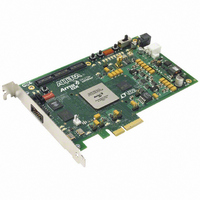DK-DEV-1AGX60N Altera, DK-DEV-1AGX60N Datasheet - Page 93

DK-DEV-1AGX60N
Manufacturer Part Number
DK-DEV-1AGX60N
Description
KIT DEV ARRIA GX 1AGX60N
Manufacturer
Altera
Series
Arria GXr
Type
FPGAr
Datasheet
1.EP1AGX20CF484C6N.pdf
(234 pages)
Specifications of DK-DEV-1AGX60N
Contents
Dev. Board, Quartus® II Web Edition, Reference Designs, Labs, and Complete Documentation
For Use With/related Products
1AGX60N
Lead Free Status / RoHS Status
Lead free / RoHS Compliant
Other names
544-2372
Available stocks
Company
Part Number
Manufacturer
Quantity
Price
- Current page: 93 of 234
- Download datasheet (4Mb)
Chapter 2: Arria GX Architecture
I/O Structure
Double Data Rate I/O Pins
© December 2009 Altera Corporation
A path in which a pin directly drives a register can require the delay to ensure zero
hold time, whereas a path in which a pin drives a register through combinational logic
may not require the delay. Programmable delays exist for decreasing
input-pin-to-logic-array and IOE input register delays. The Quartus II Compiler can
program these delays to automatically minimize setup time while providing a zero
hold time. Programmable delays can increase the register-to-pin delays for output
and/or output enable registers. Programmable delays are no longer required to
ensure zero hold times for logic array register-to-IOE register transfers. The Quartus II
Compiler can create zero hold time for these transfers.
programmable delays for Arria GX devices.
Table 2–22. Arria GX Devices Programmable Delay Chain
IOE registers in Arria GX devices share the same source for clear or preset. You can
program preset or clear for each individual IOE. You can also program the registers to
power up high or low after configuration is complete. If programmed to power up
low, an asynchronous clear can control the registers. If programmed to power up
high, an asynchronous preset can control the registers. This feature prevents the
inadvertent activation of another device’s active-low input upon power-up. If one
register in an IOE uses a preset or clear signal, all registers in the IOE must use that
same signal if they require preset or clear. Additionally, a synchronous reset signal is
available for the IOE registers.
Arria GX devices have six registers in the IOE, which support DDR interfacing by
clocking data on both positive and negative clock edges. The IOEs in Arria GX devices
support DDR inputs, DDR outputs, and bidirectional DDR modes. When using the
IOE for DDR inputs, the two input registers clock double rate input data on
alternating edges. An input latch is also used in the IOE for DDR input acquisition.
The latch holds the data that is present during the clock high times, allowing both bits
of data to be synchronous with the same clock edge (either rising or falling).
Figure 2–73
input timing diagram.
Input pin to logic array delay
Input pin to input register delay
Output pin delay
Output enable register t
Programmable Delays
shows an IOE configured for DDR input.
CO
delay
Input delay from pin to internal cells
Input delay from pin to input register
Delay from output register to output pin
Delay to output enable pin
Quartus II Logic Option
Figure 2–74
Table 2–22
Arria GX Device Handbook, Volume 1
shows the
shows the DDR
2–87
Related parts for DK-DEV-1AGX60N
Image
Part Number
Description
Manufacturer
Datasheet
Request
R

Part Number:
Description:
KIT DEV ARRIA II GX FPGA 2AGX125
Manufacturer:
Altera
Datasheet:

Part Number:
Description:
KIT DEV CYCLONE III LS EP3CLS200
Manufacturer:
Altera
Datasheet:

Part Number:
Description:
KIT DEV STRATIX IV FPGA 4SE530
Manufacturer:
Altera
Datasheet:

Part Number:
Description:
KIT DEV FPGA 2AGX260 W/6.375G TX
Manufacturer:
Altera
Datasheet:

Part Number:
Description:
KIT DEV MAX V 5M570Z
Manufacturer:
Altera
Datasheet:

Part Number:
Description:
KIT DEV STRATIX V FPGA 5SGXEA7
Manufacturer:
Altera
Datasheet:

Part Number:
Description:
KIT DEVELOPMENT STRATIX III
Manufacturer:
Altera
Datasheet:

Part Number:
Description:
KIT DEVELOPMENT STRATIX IV
Manufacturer:
Altera
Datasheet:

Part Number:
Description:
KIT STARTER CYCLONE IV GX
Manufacturer:
Altera
Datasheet:

Part Number:
Description:
KIT DEVELOPMENT STRATIX IV
Manufacturer:
Altera
Datasheet:

Part Number:
Description:
CPLD, EP610 Family, ECMOS Process, 300 Gates, 16 Macro Cells, 16 Reg., 16 User I/Os, 5V Supply, 35 Speed Grade, 24DIP
Manufacturer:
Altera Corporation
Datasheet:

Part Number:
Description:
CPLD, EP610 Family, ECMOS Process, 300 Gates, 16 Macro Cells, 16 Reg., 16 User I/Os, 5V Supply, 15 Speed Grade, 24DIP
Manufacturer:
Altera Corporation
Datasheet:











